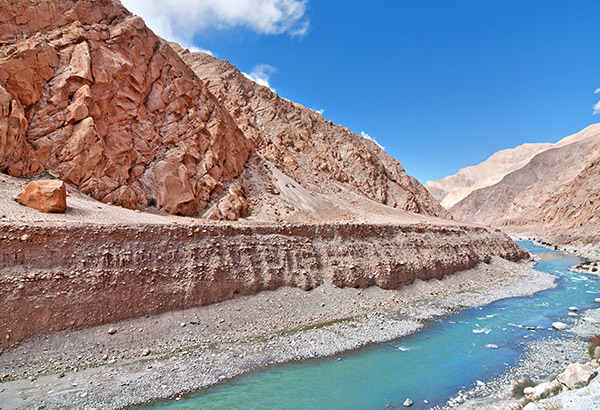
An Intensive 5-day Training Course
Fluvial Sedimentation : Principles and Application
Fluvial Facies Analysis & Borehole Images
Scheduled Dates
Classroom
| 08 - 12 Jun 2026 | Dubai - UAE | $5,950 | RESERVE A SEAT |
| 24 - 28 Aug 2026 | Dubai - UAE | $5,950 | RESERVE A SEAT |
Would an alternative date be more suitable?
We offer a variety of tailored training options, customized to meet your organisation's needs. Delivered anytime, anywhere, we make it easy to bring expert training directly to your team.
Why Choose this Training Course?
Participants on this 5-day intensive PetroKnowledge Fluvial Sedimentation training course range from petrophysicists, geologists, geophysicists or engineers who use core, borehole images, log data, core data and production data to produce or understand facies produced in a fluvial sedimentary environment. The goal of this training course is to learn to develop a G&G workflow which utilizes a variety of geological data essential to produce an accurate fluvial reservoir model.
By choosing this PetroKnowledge training course, the participants will be able to utilize all forms of data that can be used to build a fluvial geological model. Ranging from mud logs, rock cuttings, thin-sections, core, borehole images, log data, seismic and geological analogues. The participant will build and interpret facies logs, to create detailed facies maps deposited within a fluvial environment. Participants will be able, despite their different working sectors, to deal with fluvial sedimentary models, interpret facies logs and understands varying sand body architecture and geometries. As well as learning about the different tools needed to acquire the most accurate data to derive accurate facies models.
This PetroKnowledge training course will highlight:
- Understanding the fundamental different sedimentary plays within the fluvial environment
- Learn the different sedimentary flow processes that deposit within a fluvial system
- Analysis of mud logs, rock cuttings, core and thin sections to build robust facies types and facies associations
- Interpret the key features of borehole images, and interpret the dip data to determine palaeoflow direction and sand dispersal
- Understanding and utilizing geological analogues to provide the input parameters to build a fluvial reservoir model
What are the Goals?
The goal of this training course is to enable the participant to generate and interpret facies types and facies associations to build a fluvial sedimentological model that can be used to create an accurate reservoir model
By the end of this training course, participants will learn to:
- Understand different fluvial facies models and their sedimentary setting
- Interpret mud-logs, core and thin sections to produce fluvial facies logs and a facies model
- Utilize borehole images, log data, ECS and NMR to generate fluvial electro facies
- Identify accurate geological analogues, to derive input parameters for geological models
- Understand up-scaling, which honors geological data to create accurate static and dynamic geological modelling
Who is this Training Course for?
This training course is suitable to a wide range of professionals but will greatly benefit:
- Geologists
- Petrophysicists
- Geophysicists
- Reservoir engineers
- Technical project managers
- Exploration managers
- Geomodellers
How will this Training Course be Presented?
Participants to this training course will receive a thorough training on the subjects covered by the seminar outline with the Tutor utilising a variety of proven adult learning teaching and facilitation techniques. Seminar methodology including traditional power points, videos, group projects, interactive discussion and participants presentations.
Organisational Impact
The organizational impact:
- Better synergy between disciplines
- Smarter workflows increasing the work efficiency
- Better understanding of the evolution of data from acquisition to reserve calculation
- Improve data acquisition to acquire only essential data necessary to reduce uncertainty
- Improve the quality of the static and dynamic model to reduce drilling risks
Personal Impact
- Gain knowledge in other disciplines
- Produce smarter workflows increasing the work efficiency
- Learn to apply better geological facies models
- Reduce costs by improving data acquisition
- Improve career growth by improved workplace understanding
Daily Agenda
Day One: Overview of the Alluvial and Fluvial Environment - The different Types of Physical Processes
- Alluvial and fluvial processes from braided to meandering channels
- Different type of physical processes from tractional to suspended flows
- Different types of river morphology and their impact on sedimentation
- Classification of fluvial clastic systems
Day Two: Fluvial Sedimentation – Facies Characteristics of Different River Morphologies
- Understand different types of alluvial and fluvial systems
- Identify the different controlling processes and their facies and facies associations
- Sand body architecture and geometries
- Review the Petrophysical parameters and facies
Day Three: Creating Electrofacies Utilizing the mudlog, Rock cuttings, Core, Borehole Images to Produce Facies Types
- Principle of Borehole images and interpreting Electrofacies
- Dip picking and dip interpretation in fluvial facies
- Palaeocurrent analysis and sediment dispersal patterns
- Creating electro facies incorporating core, log data, NMR and ECS – defining cut-offs
Day Four: Case Studies
- Outline of classical outcrop examples
- Subsurface fluvial plays
- Utilizing seismic data
- Using analogues to input parameters for the static model
Day Five: : – Case Studies – Group Project & Presentation
- Recognizing facies from core
- Identifying facies from borehole images
- Determine sedimentological model
Certificate
- On successful completion of this Training Course / Online Training Course, a PetroKnowledge Certificate / E-Certificate will be awarded to the delegates.
